 by James A. BaconCollege Simply
by James A. BaconCollege Simply
‘s 2023 Best Value Colleges in America ranks the University of Virginia as the 2nd “best value” among public colleges and universities in the United States in 2023. The best-value distinction is conferred upon institutions that provide students the most academic prowess for the money (defined as net tuition after financial aid to the student).
When critics of UVa governance accuse the university of supporting excess administrative overhead, a common response is: if UVa is so bad, how come it’s the second-best value among all public institutions?
That’s a fair retort and well worth exploring. In this column, I suggest that UVa has restrained the highly visible and politically sensitive metric of undergraduate in-state tuition not through budgetary belt-tightening but by pursuing two strategies: (1) maintaining a favorable ratio of students who pay the full freight versus those who require financial assistance; and (2) increasing enrollment for out-of-state post-graduate students who pay higher tuition than in-state students. Much if not all of UVa’s perceived superior value comes from tuition-and-admissions engineering.
UVa’s tuition revenue rose 276% between 2002 and 2022, far exceeding inflation (59%) and enrollment growth (20%). How was that achieved?
The first table below compares the percentage of lower-income students at UVa versus the percentage at all Virginia four-year colleges and universities. The percentage of lower-income students at UVa is 12.2 points lower — equivalent to one-eighth of the student body — than the state average. Compared to institutions serving lower-income populations such as Norfolk State University, the lower-income gap is 37 percentage points.
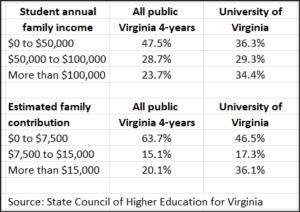
The practical consequence is that the percentage of students paying the full tuition at UVa is much higher than the state average — 36% paying $15,000 or more compared to only 20% for Virginia’s public four-year institutions as a whole (and 5% at Norfolk State). Thus, UVa admissions strategy yields more revenue per student on average than for most other institutions.
UVa’s other strategy is to increase the percentage enrollment of out-of-state students in medical school and many graduate-level programs, which charge out-of-staters significantly higher tuition.
Increasing tuition & fees for in-state undergraduate students leads to outcries among parents and prospective parents, who raise hell with their state lawmakers who, in turn, create legislative mischief for UVa. By contrast, out-of-state parents upset by high tuition have no political voice. The only thing holding back tuition increases for them is competition from other elite institutions… all of which have been ratcheting rates higher as well.
At the same time, reducing the percentage of in-state undergraduate students is politically perilous. Lawmakers would hear about it if UVa cut the number of undergraduate in-state students, depriving constituents of the opportunity to send their offspring to Virginia’s flagship university. With small year-to-year fluctuations, UVa has consistently maintained the fraction of in-state undergraduate students at around two-thirds.
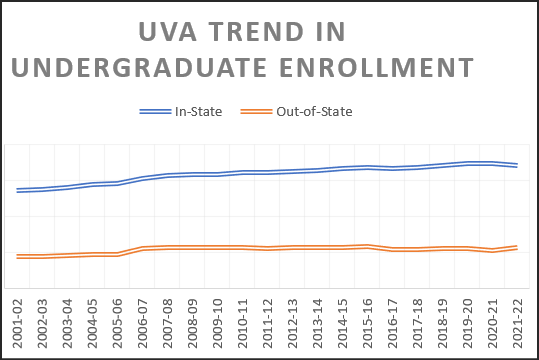
Conversely, political blowback from tinkering with in-state/out-of-state ratios for graduate and professional schools has been non-existent. Not surprisingly, UVa has seen a marked decline in the percentage of in-state graduate students and a corresponding increase in out-of-state graduate students.
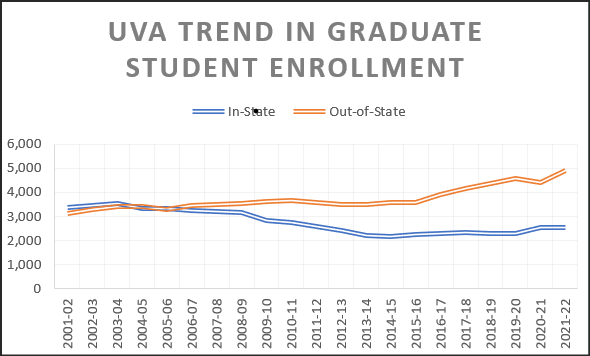
In 2002 in-state graduate students at UVa roughly equaled the number of out-of-state graduate students. Around the 2006-07 academic year the ratio began shifting in favor of out-of-state students. Today, the ratio stands at one in-state graduate student for every two out-of-staters.
An identical trend can be seen among “first professional” students, a category encompassing those who pursue law, business, and a variety of medical degrees.
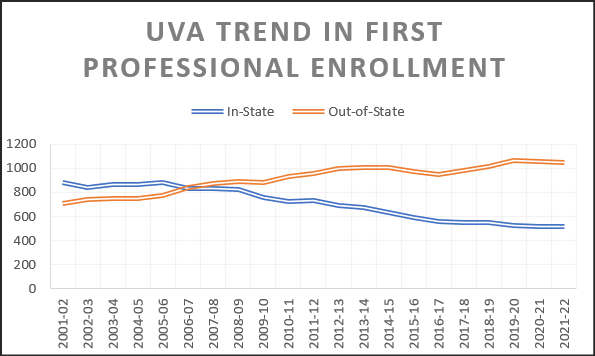
Among first professionals the shift has been even more pronounced. In 2002 the in-state/out-of-state ratio stood at 1.2-to-1. Today, it is 0.5-to-1.
The financial logic behind this shift is evident when comparing the tuition charged to in-state versus out-of-state students. The following tuition charges are extracted from the tuition summary presented in December 2022 to the Board of Visitors.
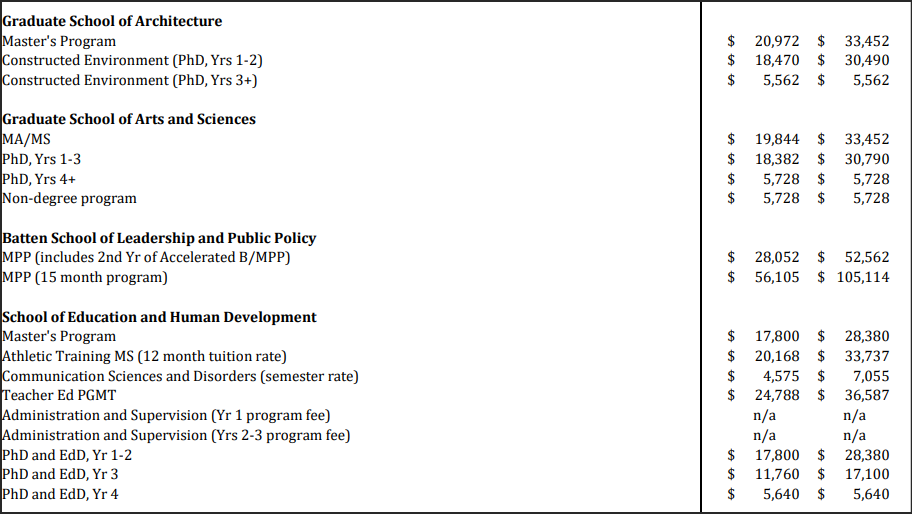
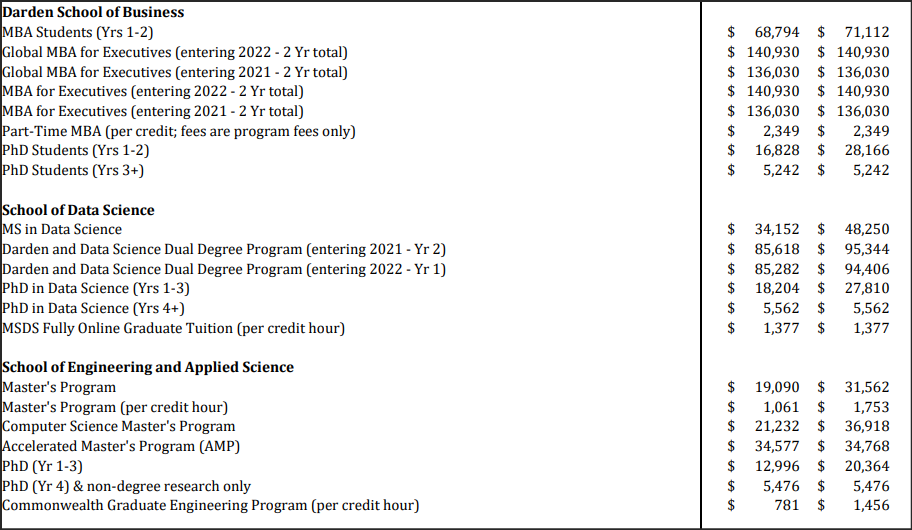
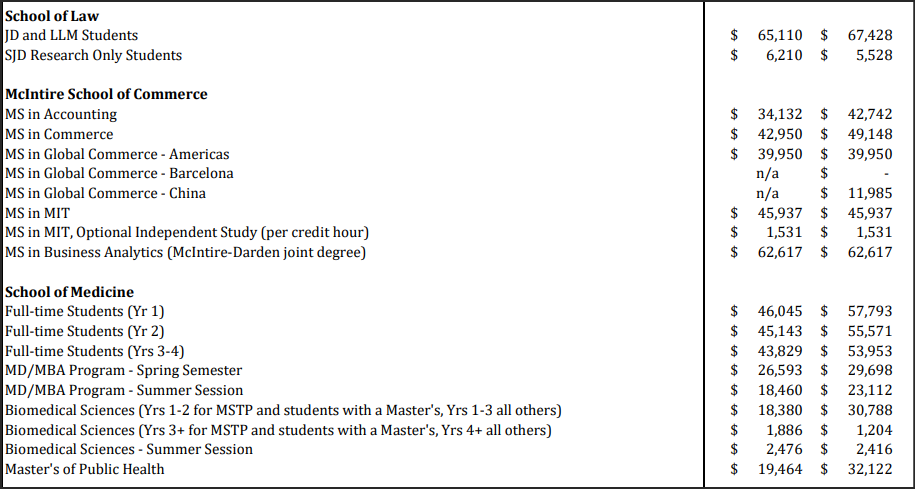
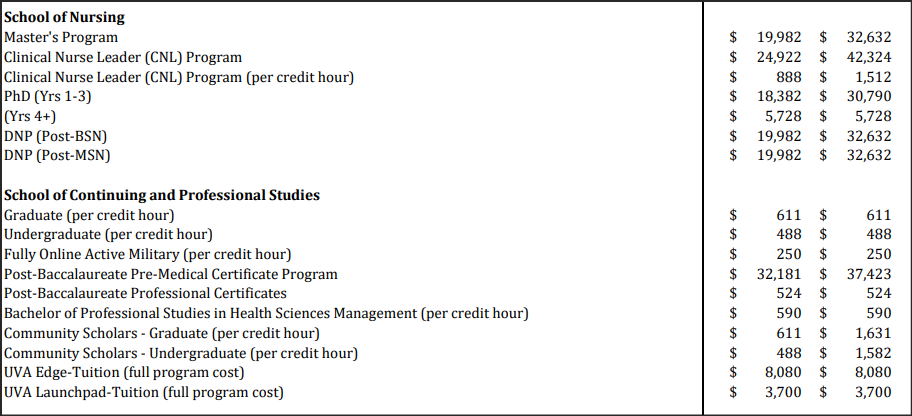
UVa’s Darden School of Business and School of Law are highly autonomous operations, nationally regarded as the most prestigious schools within the university, and they cater to a national market. They give little preference to in-state Virginia students and charge nearly the same stratospheric tuition. But all other schools and colleges charge out-of-state students significant premiums — generally in the range of $12,000 to $14,000.
To see what a difference this makes, let us assume a $12,000 premium for out-of-state graduate students typical of 2022. If UVa had maintained the in-state/out-of-state ratio that prevailed in 2002, it would have generated $171.5 million in tuition revenue. By contrast, increasing enrollment of out-of-state students to 2022 levels would have generated $222.4 million in tuition revenue — about $50 million more. Similar differences would have been found for medical school first-professional students.
For context, tuition revenue from all sources in 2022 totaled $669 million.
Bottom line: one can acknowledge that UVa is a “best value” university for in-state undergraduate students without crediting the University with taming administrative bloat. The good news here is that there is vast room for improvement should President Ryan and the Board of Visitors get serious about working off that unsightly bureaucratic bulge.

Leave a Reply
You must be logged in to post a comment.